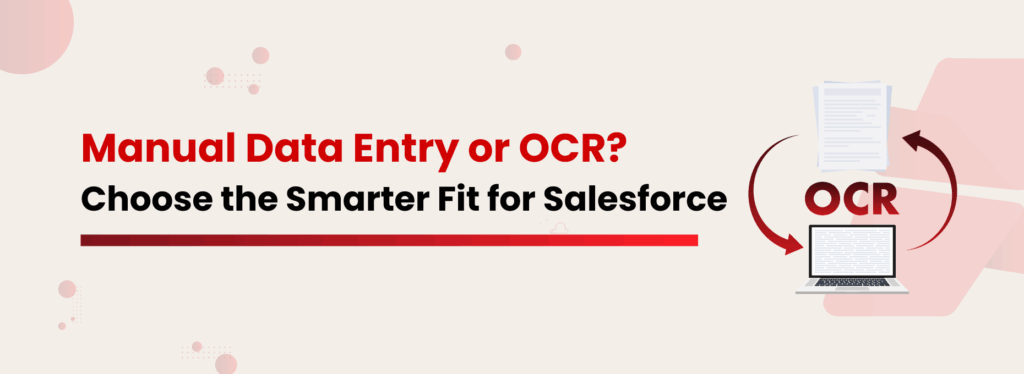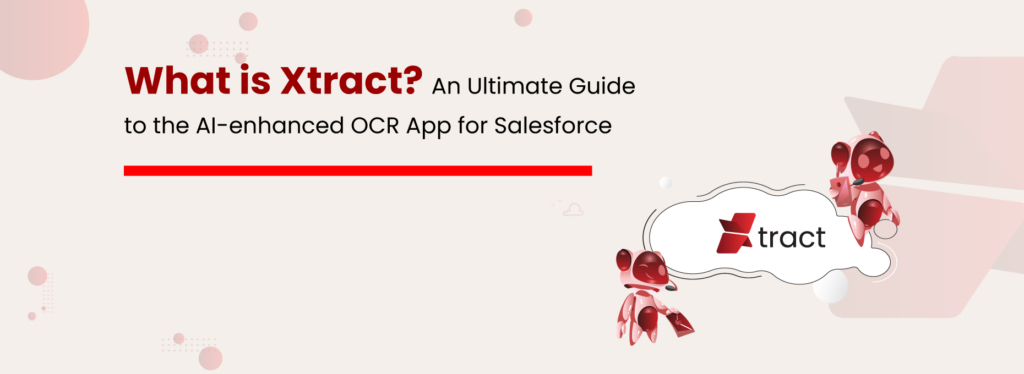Manual Data Entry or OCR? Choose the Smarter Fit for Salesforce

Data is the lifeblood of your business workflow. From customer onboarding forms to service request documents and compliance reports, our business is drowning in data-heavy processes that demand accuracy and speed. When we refer to data-heavy operations, it also means the manual process of transforming handwritten or paper-based document information into digital content. This practice has been the norm for decades, as manual data processing is often seen as a guarantee of trustworthiness. But today, OCR data extraction or Optical Character Recognition is changing the game. With automated data extraction becoming more accessible and accurate, Salesforce users started adopting OCR expertise to streamline their daily work. However, many are still uncertain about OCR, as manual data entry is still widely trusted and executed. Let’s discuss it in this article! Understanding Manual Data Entry vs OCR Data Extraction We all know about manual data entry. It’s the traditional process of inputting information about customers, invoices, or form submissions into the system. OCR (Optical Character Recognition) data extraction, on the other hand, automates this process by scanning documents, including PDFs, images, and printed forms, and converting them into structured Salesforce records. This advanced technology identifies printed or handwritten text within these files and transforms it into machine-readable formats. How are both manual data entry and OCR data extraction different in Salesforce? Here’s a closer look at how both approaches compare across the business-critical factors. Speed and Efficiency Manual Data Entry in Salesforce: It’s a slow, resource-heavy process that demands extensive human effort. Handling large volumes of documents manually can consume hours of work and tie up your team in repetitive tasks. OCR for Salesforce: Exceptionally fast and efficient. Salesforce data entry automation can handle hundreds or even thousands of documents in a fraction of the time, allowing your team to focus on more strategic operations. Accuracy Manual Data Entry in Salesforce: Manual data entry is prone to human error, misspelled names, overlooked fields, or incorrect values that can easily slip in, affecting overall data reliability and decision-making. OCR for Salesforce: An advanced, AI-driven OCR solution can offer high levels of accuracy, especially with printed documents. While occasional errors may occur, intelligent algorithms can detect ambiguities, learn from corrections, and continuously refine performance over time. Cost Efficiency Manual Data Entry in Salesforce: Here, the ongoing costs such as hiring, training, managing errors, and maintaining teams add up and make it an expensive process over time. OCR for Salesforce: Although it may require an upfront investment, it pays off quickly with lower operational costs and increased processing efficiency. Scalability Manual Data Entry in Salesforce: Scaling is a challenge in manual data processing. As document volume grows, so does the need for additional manpower, training, and oversight, making it costly and inefficient. OCR for Salesforce: Salesforce data entry automation is designed to scale effortlessly. Whether you’re handling a few hundred or hundreds of thousands of documents, OCR-powered functionality for Salesforce adapts seamlessly without increasing operational overhead. Security & Compliance Manual Data Entry in Salesforce: Manual data processing can lead to human errors, data loss, and security breaches, especially when relying on physical records or unsecured systems. OCR for Salesforce: OCR technology enhances data security with encryption, access controls, and detailed audit logs. It also simplifies compliance with industry regulations and data privacy laws. Document Management Workflow Manual Data Entry in Salesforce: Here, you often need to operate in silos with minimal system integration that could cause delays and workflow disruptions due to human dependencies. OCR for Salesforce: You can easily connect with document management systems and automation tools, enabling smoother workflows, real-time updates, and greater process transparency. So, overall, what do you think? Does your Salesforce workflow demand manual data entry or OCR data extraction? Undoubtedly, OCR technology is the winner! How Does OCR Technology Help in Daily Life? Let’s look into some use cases of OCR data extraction for different industries. Healthcare: OCR can extract data from patient intake forms, prescriptions, and lab reports, then automatically reflect them in the respective records. This streamlines patient onboarding and ensures accurate, centralized health records.Finance & Banking: Banks and financial institutions use OCR to capture data from KYC documents, bank statements, and loan applications. The extracted data flows into your Salesforce workflow, accelerating customer onboarding and ensuring regulatory compliance. Legal: Law firms scan contracts, legal briefs, and case documents using OCR, which extracts critical information like client names, dates, and clauses. This data is then mapped to Salesforce case records, enabling quick access and efficient case tracking.Logistics: OCR reads shipping labels, delivery notes, and bills of lading to automatically feed the data into Salesforce. This ensures real-time shipment tracking, fewer errors, and smoother coordination across supply chain operations.Retail & eCommerce: Retailers use OCR to extract details from order forms, invoices, and receipts, syncing the data with Salesforce for inventory and vendor management. This helps streamline order processing, reduce errors, and maintain accurate stock and financial records. OCR: The Winner It’s clear now! OCR technology wins over manual data entry for your Salesforce workflow, given the speed, accuracy, scalability, and cost-efficiency of OCR. As more Salesforce users seek to streamline operations and improve bottom lines, the adoption of OCR is critical for your document management operations. At XfilesPro, we make it easier for you to adopt OCR for your Salesforce document management workflow. For this, we offer advanced, AI-powered data extraction capability that converts documents into editable and searchable data and maps with your corresponding Salesforce record. If you wish to learn more about XfilesPro’s AI-enhanced OCR functionality for Salesforce, please hit us up! Deeshna CDeeshna is a five-year experienced writer in the field of B2B, writing a wide range of content types that drive the success of SaaS products. All Posts www.xfilespro.com
Why Businesses Need an OCR Solution in Salesforce?

Ever received a PDF or image where you couldn’t copy a single word? Your first instinct might be to convert it into another file format just to extract the details. But when you’re dealing with document-heavy processes inside Salesforce, does this workaround scale? Absolutely not. That’s where Optical Character Recognition (OCR) steps in. This intelligent technology extracts text from scanned images and PDFs, turning printed or handwritten content into machine-readable data. And when embedded within Salesforce, the results can be game-changing. Why is OCR Critical for Salesforce? In ecosystems like Salesforce, where data drives every decision, OCR plays a pivotal role. Businesses frequently handle contracts, invoices, agreements, work orders, customer onboarding forms, and compliance documents – often in non-digital formats. Without automation, manual data entry poses challenges. It’s not only time-consuming, but also prone to human error, which can lead to inaccuracies and work discontinuity. Also, as the document volumes grow, your teams often struggle to scale their efforts efficiently, resulting in backlogs and delays. Beyond operational headaches, there’s also a risk to data security and compliance where even a small mistake can result in regulatory breaches or mishandled sensitive information. Altogether, these challenges spill over into the customer experience! How Does OCR Enhance Salesforce Workflows? Integrating Optical Character Recognition (OCR) with Salesforce can transform how your team handles data. By automating tedious, error-prone tasks, OCR streamlines operations and boosts the accuracy and speed of the data obtaining process. Here’s how OCR technology enhances your Salesforce workflows; Automated Data Extraction OCR technology can intelligently scan and extract data from a variety of sources, including scanned documents, PDFs, and image files. This eliminates the need for manual input, converting unstructured or hard-to-access data into organized, Salesforce-ready formats with minimal effort. Improved Accuracy Powered by Artificial Intelligence (AI), modern OCR tools significantly reduce human errors in data entry. By accurately recognizing characters and validating data formats, OCR ensures the information entering your Salesforce environment is reliable and consistent. Seamless Integration OCR solutions can be configured to integrate directly with Salesforce, which allows extracted data to populate standard and custom objects automatically. This not only streamlines workflows but also ensures that your Salesforce instance stays up-to-date in real time without manual syncing. Faster Processing & Decision-Making OCR dramatically accelerates the speed at which documents are processed—what once took hours can now be done in minutes. By making critical data available faster, your teams can make quicker, data-driven decisions and respond more promptly to customer needs. Key Benefits of Using an OCR Solution in Salesforce Implementing an OCR solution within Salesforce brings a range of valuable benefits. It boosts productivity by freeing employees from time-consuming manual data entry, instead allowing them to focus on higher-value tasks. This advanced technology also helps ensure compliance and data security by reducing human error and supporting proper handling of sensitive information in line with regulations like GDPR and HIPAA. Plus, you can benefit from cost savings, as automation reduces the need for additional resources and cuts operational expenses. Most importantly, through OCR technology, you can enhance the customer experience by speeding up document processing, enabling quicker responses, and more efficient service delivery. Let’s look into some instances where OCR for Salesforce comes in handy. Invoice Processing OCR can automatically extract key information from invoices, such as invoice number, date, line items, and total amount, and populate it directly into Salesforce. This reduces manual entry, speeds up the approval process, and ensures accurate financial records. Contract Management By digitizing physical or scanned contracts, OCR enables you to easily store, search, and manage legal agreements within Salesforce. It streamlines contract lifecycle management and ensures important clauses or dates are never missed. KYC & Identity Verification OCR can extract relevant data from documents like passports, driver’s licenses, or utility bills to accelerate Know Your Customer (KYC) processes. This improves onboarding efficiency and helps maintain compliance with regulatory requirements. Healthcare Records Management In healthcare environments, OCR can convert handwritten or scanned medical documents into structured, searchable records within Salesforce. This allows for faster access to patient information and better coordination across care teams. Claims Processing in Insurance OCR can streamline insurance workflows by extracting data from claim forms, supporting documents, and images submitted by customers. This automation accelerates the claims review process, reduces errors, and improves turnaround time for customer payouts. How to Choose the Right OCR Solution for Salesforce? It’s no longer automation that redefines the game — it’s Artificial Intelligence (AI). When selecting a modern OCR solution for Salesforce, you need to look for AI-powered recognition capabilities that ensure high accuracy, even with low-quality scans or complex layouts. The right tool should also support a wide range of file formats—from PDFs and scanned images to handwritten documents—so you’re not limited by input type. Similarly, seamless integration with Salesforce is key for automating workflows and ensuring data flows directly into the right objects without manual intervention. Keep in mind, you shouldn’t overlook security and compliance features; robust encryption, access control, and adherence to standards like GDPR or HIPAA are essential when handling sensitive information. Begin Your OCR Journey for Salesforce OCR technology is transforming the way businesses manage documents within Salesforce by turning time-consuming manual tasks into streamlined, automated processes. Given the huge potential of this modern method, why can’t your business leverage its benefits? Now is the time to embrace the shift and work smarter to serve customers better. We urge you to explore Xtract, our OCR solution for Salesforce, to experience a streamlined data extraction method. Hit us up today! Deeshna CDeeshna is a five-year experienced writer in the field of B2B, writing a wide range of content types that drive the success of SaaS products. All Posts www.xfilespro.com
What is Xtract? An Ultimate Guide to the AI-enhanced OCR App for Salesforce

OCR is no longer a foreign concept for us. We witness a lot of businesses leveraging Optical Character Recognition (OCR) programs as part of their daily operations — and now, Salesforce users also rave about its potential. If you’re still unsure how OCR can add value to your business, let us help you learn about it in detail. In simpler terms, OCR is a technology that recognizes text within an image. Businesses often use an OCR program to extract and repurpose data from scanned documents, camera images, and image-only PDFs. OCR software identifies individual characters, assembles them into words, and then forms complete sentences — that way, transforming static images into machine-readable text. With advancements in artificial intelligence (AI), OCR has evolved to the next level. It’s no longer a conventional OCR that simply extracts information from a Salesforce document; it is an advanced solution that offers greater work efficiency. Let’s discuss some key benefits of AI-powered optical character recognition technology in your Salesforce environment. Higher Accuracy Manual data entry is prone to errors, causing inefficiencies and reputational damage for your business. Having a modern OCR program eliminates the need for manual typing by automatically extracting text from files and attachments inside Salesforce. This makes your documents and image files easily searchable and processable and ensures high data consistency. Improved Scalability Whether your business is small or large, an AI-enhanced OCR technology can meet both demands. That means an optical character recognition software is designed to grow with the evolving needs of your company and can handle a small business’s document processing needs as effectively as those of a large enterprise. Faster Turnaround Time Due to cumbersome tasks that create expensive bottlenecks, traditional document processing workflow mostly gets delayed. This results in customer dissatisfaction and inefficient operations that ultimately take a toll on your brand reputation. An OCR system can accomplish accurate data extraction in a matter of seconds, which saves 98% of time and reduces process delays. The Ultimate Solution Now that you understand the advantages of AI-powered OCR technology, let us introduce you to Xtract, an AI-powered application for extracting details from your business documents. What is Xtract? Xtract is the newly launched AI-enhanced application from the house of XfilesPro. Leveraging OCR technology with the power of AI, the application extracts textual information from a Salesforce document and uses it for a relevant use case. Xtract’s AI engine is so robust that it scans every document and image associated with a record and automatically initiates extraction. Once the data is pulled, the application maps them precisely with respective Salesforce fields to keep the details up-to-date. The best part is that Xtract’s AI engine ensures the accurate and consistent entry of extracted details to the fields, meaning you can achieve peace of mind. Xtract’s OCR technology can be applied in a variety of business scenarios to enhance efficiency and accuracy. Here are some of those. Invoice Processing : Automating the extraction of data from invoices, receipts, and financial statements by speeding up the accounts payable process. Handwritten Notes Recognition : Efficiently digitizing doctors’ handwritten prescriptions and notes for easy access in the healthcare domain. Receipt Scanning : Extracts the purchase details of expense management and pulls the relevant details as a helping hand for workers in retail and e-commerce. Digitization of Books & Study Materials : Converting printed books, guides, and journals into digital formats for smooth learning and reference. Form Processing : Intelligently automates the data entry for tax forms, census records, and permit applications for the legal and government sector. Taking OCR to the Next Level with AI and Xtract If your business needs to improve the bottom line and enhance customer experience, Xtract can be a wise addition to your operations. If you wish to learn more about how best Xtract can work for your business, do Connect with us! Our team is happy to take this forward! Deeshna CDeeshna is a five-year experienced writer in the field of B2B, writing a wide range of content types that drive the success of SaaS products. All Posts www.xfilespro.com

